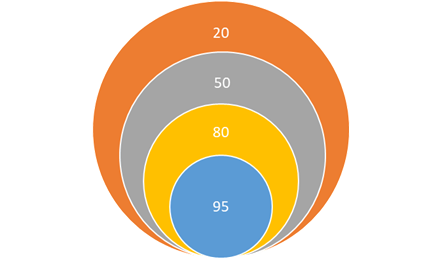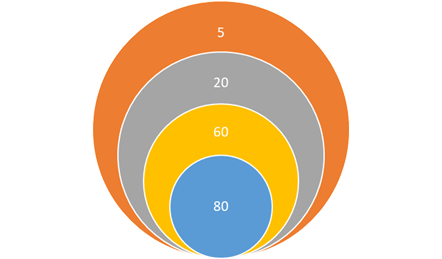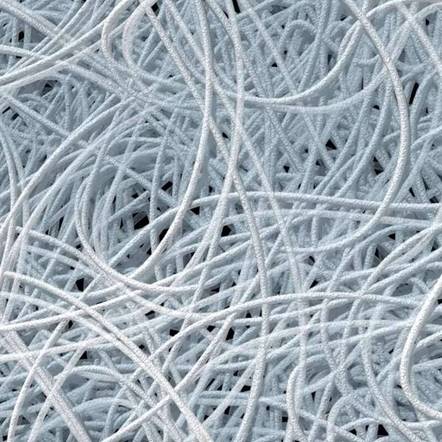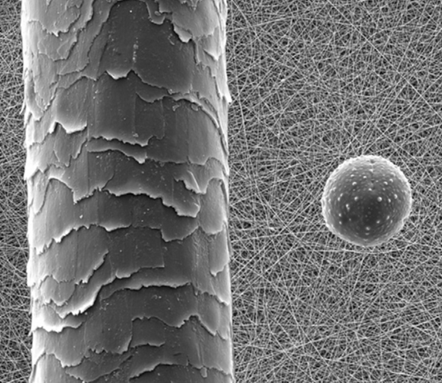
CATER Mask
Decisions
December 9, 2020
ASTM Base Efficiency Requirement can be Combined
With More Efficient Masks to Greatly Reduce
COVID Transmission
ASTM Working with CDC on a Minimum 20%
Efficiency Mask
Are Nanofiber Media Masks More Comfortable?
International Filtration News Insights
_____________________________________________________________________________
ASTM Base Efficiency Requirement can be Combined
With More Efficient Masks to Greatly Reduce
COVID Transmission

There are presently many masks being worn where
even with a perfect fit the efficiency will be
well less than 20%.
So an ASTM standard which would result in
all masks being somewhat effective will be a
contribution. With CATER Mask Decisions
we hope to guide a majority of purchasers to
purchase much more efficient masks.
Mask Efficiency by Percentage of Wearers
At the very least we should be able to achieve a
distribution where 20% are wearing masks which
are 80% efficient or greater and 10% are wearing
very efficient masks. The masks are part of the
swiss cheese defense program. The fewer holes in
the mask layer, the less need there is to
eliminate holes in the ventilation layer or in
quarantine.

The ASTM working group struggled to find
compromise on inward leakage testing. There is
no consideration of quality control. So the
reality in terms of virus protection ranges
roughly from 5 to 80%.

Mask Effectiveness by Percentage of Wearers
It is therefore important that the ASTM standard
be supplemented by evaluation systems which
provide net effectiveness even if it is a range
such as shown in the following chart.
|
Effectiveness Rating % |
||
|
|
Minimum |
Maximum |
|
Level 1 |
0 |
10 |
|
Level 2 |
10 |
30 |
|
Level 3 |
50 |
70 |
|
Level 4 |
70 |
95 |
This effectiveness rating could be
net efficiency as calculated in the
following example.
|
Mask |
Efficiency % |
Unfiltered % |
Defects |
Net Efficiency % |
|
CATER 99 |
98-99 |
-2-8 |
0-1 |
89-97 |
|
CATER 95 |
92-97 |
-2-8 |
0-1 |
83-95 |
|
CATER 93 |
90-95 |
-2-8 |
0-1 |
82-93 |
|
Cloth |
50-60 |
-30-50 |
5-10 |
15-37 |
|
Surgical |
92-97 |
-25-40 |
0-1 |
40-72 |
ASTM Working with CDC on a Minimum 20%
Efficiency Mask
Obtaining agreement of mask standards is
difficult considering the revenues for
inefficient masks are many billions of dollars
per year. So the fact that ASTM has been working
with CDC and can probably have a consensus on a
minimum 20% efficiency mask is significant.
Also the clarification of methods to test
efficiency is also an important part of the
effort
This week the group received a
request to vote on
Ballot
Action: Working Draft #7, Standard Specification
for Barrier Face Coverings
This draft incorporates recommended changes from
the work group provided on Draft #6. A number of
specific changes have been made in response to
recent teleconferences to find potential areas
of consensus. Many of these comments are
substantial particularly as related to leakage
assessment, labeling, and conformity assessment.
Here are some
of the notes and clauses relative to
leakage assessment.
Note 4
– The leakage assessment represents the total
inward leakage likely to occur during wear.
Whether measured quantitatively or
assessed qualitatively, the leakage assessment
does not represent the likely outward leakage of
particles generated by the wearer. Thus, no
claims may be made with respect to the degree of
source control offering by the barrier face
covering based on the leakage assessment.
Note 5
– Leakage assessment, if measured quantitatively
on a barrier face covering that rests closely on
the face and thus has minimal inward volume, may
not be representative of true inward leakage.
4.1.3 Sub-micron particulate filtration
efficiency and air flow resistance do not
account for the leakage of air around the
perimeter of the barrier face covering. A
leakage assessment using a design analysis of
the product is required to assess the ability of
the barrier face covering design to minimize
inward leakage and provide appropriate coverage
for a range of wearer faces of different
dimensions. The design analysis can be conducted
by the manufacturer in a number of different
ways. The standard also permits supplemental the
use of quantitative information obtained from a
modified form of Test Method F3407 using test
subjects. This test yields a reportable ratio of
outside particulate concentration to the
concentration of particles in the wearer’s
breathing zone. Thus, a leakage ratio of 1.0
indicates the outside and inside environments
are equal and that particulate flow through gaps
in the barrier face covering (in addition to any
particulate that pass through the filtration
materials of the product
5.4 Leakage Assessment
5.4.1 The
leakage assessment shall be reported by
the manufacturer through a product design
analysis self-declaration.
5.4.2 The required self-declaration shall report
that the product minimizes leakage around the
edges or other areas of the product based upon
an analysis of the product design.
This statement can be included on any
self-declaration required as part of Guide
F3050, under Section 12 of this specification.
5.4.2.1 The manufacturer is permitted to conduct
quantitative testing
to supplement its product design analysis
self-declaration. When used, the leakage ratio
shall be evaluated using Test Method F3407, with
the modifications specified in 8.3.
5.4.3 Where barrier face coverings are reusable
and intended for laundering or cleaning, the
product design analysis shall be applied to
barrier face coverings both in a new condition
and after the maximum of laundering or cleaning
cycles as specified by the manufacturer
according to the manufacturer care instructions.
Note
13 – Examples of means to accomplish a leakage
assessment could include dimensional analysis,
computer modeling, placement of barrier face
coverings on standardized head or head-torso
forms and judging their respective areas of
coverage and conformity to the head or
head-torso form face showing conformance to the
fit and sizing characterizations of AATCC
M14-2020, or performing a quantitative analysis.[1]
A minimum particulate efficiency is cited
|
Performance
Property |
Criteria |
Test Method
Section |
|
Sub-micron
particulate
filtration
efficiency |
≥ 20% |
8.1 |
|
Air flow
resistance,
inhalation |
≤ 15 mm H2O |
8.2 |
Subsequently in the draft is an example showing
a better level 2 performance.
TABLE 2 Separate Classification of Face Covering
Performance PropertiesA
|
Performance
Property |
Level 1
(Acceptable) |
Level 2 (Better) |
|
Sub-micron
particulate
filtration
efficiency
(Effectiveness
of barrier face
covering for
capturing small
particles from
wearer; larger
percentages
indicate higher
performance) |
≥ 20% |
≥ 50% |
|
Air flow
resistance
(Indicative of
ease of
breathing while
wearing barrier
face covering;
lower
resistances
indicate more
breathable
products) |
≤ 15 mm H2O |
≤ 5 mm H2O |
This ASTM standard is a sign of progress.
It alerts buyers that all masks are not
equal. Suppliers of 95% efficient masks with
less than 8% inward leakage can use this
standard as a base and provide evidence as to
why their product achieves their claims,
Are Nanofiber Media Masks More Comfortable?
Revolution fibres make a
case that not only do nanofibers have
efficiency and breathability advantages they are
also more comfortable.
Nanofibers are incredibly small, synthetic
fibers – each measuring one thousand times
thinner than a human hair. Nanofibers form
complex strength through spiderweb-like
structures, which have an advantage over
conventional or even natural fibers due to their
extraordinarily large surface area and tiny pore
size. This combination creates maximum air flow
and particle capture – significantly more than
other synthetic or natural filters, achieving
greater efficiency down to PM0.3 microns.

This image helps us visualize the size of a
nanofiber when compared to both hair and a speck
of pollen:

Its small size provides an array of benefits
when utilized in face mask technology –
including advanced protection and better
comfort.
Featuring a weaving design closely packed
together so microscopically that we are unable
to see them with the human eye, nanofibers craft
a small pore size and high surface-to-volume
ratio. This means the surface area and pores of
a face mask with nanofiber technology will not
allow cells to pass through to reach the wearer.
Simply, due to the unique and tough threading of
the nanofibers, everyday dangers such as
pollution, viruses, bacteria and more will be
unable to cross the threshold of the mask,
thereby enhancing protection from the outside
world. Not even water or liquid can penetrate
the surface, which is why it is such an
essential component of any truly effective face
mask.
Additionally, this works two ways, as a mask is
not only a protector of the individual wearing
the mask, but it also serves to halt the spread
of germs as well. When you’re sick, you should
have a mask on – especially if there are other
people in your household or if you are traveling
out to an appointment with a doctor. Nanofibers
block larger cells from escaping the mask, which
helps to ensure less spread of any unpleasant or
harmful ailment to unsuspecting passersby or
loved ones.
While many are aware of the advanced protection
that nanofibers provide in face mask technology,
what may come as a surprise is that this
material is also significantly more comfortable
than other fibers. The complexity of the
microscopic hair-like design makes the mask
lightweight and, therefore, extremely
breathable. It’s not simply a cloth over your
face – it’s a material that works with your body
to trap cells out but allow air to flow in, so
you don’t feel cramped or suffocated. This also
allows for better temperature regulation. More
airflow means less of a “humid” feeling, as if
the mask were a part of your face rather than
your face feeling as if it’s sweating into the
mask. The light, soft and airy material of
nanofibers ensures both short-term and long-term
wear is much more comfortable.
Overall, nanofibers have revolutionized the way
we keep people safe – with transformational
applications in healthcare advancements such as
tissue engineering, wound dressings, face masks
and more.
International Filtration News Insights
International Filtration News
has lots of good information relative to masks
We work closely with Matt Migliore who is the
editor. He just wrote an article on nanofibers
which is quite relevant. Here are some excerpts.
According to Dr. Vijayakumar, to truly deliver
on the benefits of increased efficiency and
decreased resistance in the filter, nanofibers
need to be in the ~100nm size range.
NXTNANO’s HYPR spinning production process is
capable of scaling to produce approximately 150
million square meters of Level 1 mask material
per year, according to McDowell. Described as a
derivative of electrospinning, the HYPR spinning
process allows NXTNANO to produce more and finer
fiber, more consistently, and with better
bonding than other nanofiber material options on
the market. It also permits flexibility to spin
multiple polymers simultaneously. “All of the
general issues you would see with
electrospinning we think we’ve pretty well
solved; for throughput, controllability, and
uptime,” said McDowell.
You can find the full article at
https://www.filtnews.com/nanofiber-filtration-challenges-and-opportunities/
There is an important article by Adrian Wilson
titled Facemask
materials, surface treatments, intelligent
sensors & carbon nanotubes.
Here is an excerpt.
NWI executive director Benham Pourdeyhimi
explained that the new media development arose
from reactivated work on microfibrillation,
which was initially undertaken for the
filtration industry.
N95 efficiency can be achieved with just two
layers of the new spunbond fabric. A combination
of one spunbond layer and a meltblown layer can
further achieve N99 efficiency.
The media also requires no electrostatic
charging, which has been another bottleneck in
the production of facemasks this year, and,
because the materials are strong – unlike
traditional meltblown materials – they can also
be cut and sewn by traditional techniques.
Further, they have the potential to be reused a
number of times after cleaning.
The full article is found at
https://www.filtnews.com/filtration-innovations-in-2020/
